Kuala Sepetang (Kuala means “estuary”, in Malay) is a small fishing village located off the Taiping, Perak state coast, and the gateway to the largest unbroken expanse of mangrove swamp forest remaining in Peninsular Malaysia – The Matang mangrove forest (40,537 ha), a truly fascinating place to observe a natural wetland ecosystem at work. Recently, I spent some time there, which included staying at one of the government built chalets. The Forestry Department has established a (well run) eco-educational centre at the Kuala Sepetang site. If you are in the vicinity of Taiping town, the Kuala Sepetang Wetlands is a must visit.
The mangroves is the dominant feature of the coastline here, which is almost entirely flat for miles around, except for the nearby peaks of Gunung (Mount) Bubu, and Bukit Larut (Maxwell Hill). This land is almost entirely cultivated and settled, except for the coast. The unique thing here is that the Matang mangroves have long been touted as a good model of sustainable mangrove forestry and conservation.
Since the early 1900s, the mangrove forest here has undergone a sustainable logging program, and the result is that the region continues to produce timber while retaining its forest cover in perpetuity. At the same there are also large tracts of undisturbed mangroves remaining within this vast coastal forest reserve. Although mangrove trees grow a lot faster than typical lowland tropical rainforest trees further inland (and thus cannot be compared to the latter), this prudent system of forest management is still something that Malaysia can be proud of.

The landscape around Kuala Sepetang is all flat, except for the mountain peaks of Bubu and Bukit Larut, seen here in the near distance, looking upstream of the Sungai Reba.
This enviable record of sustainable forest management is evidenced by the good quality of the current mangrove stand. The Rhizophora trees here are the tallest and biggest mangrove trees I have ever come across, far taller than the trees in Kuala Selangor Nature Park (which in truth, is a regenerating mangrove forest) or the ones off the Port Klang/Selangor coast.
If you want to see an authentic mangrove forest complete with intact biodiversity, then this is the place to be…
Getting there
Kuala Sepetang is a fishing village within the large Larut, Matang, and Selama District of Perak. It is easily reached from Taiping town by means of the 11 km trunk road; just follow the signboards to Kuala Sepetang, and keep straight all the way. If coming from the PLUS highway, just exit at the Changkat Jering toll and head to Taiping, before turning onto the trunk road that goes to Kuala Sepetang.

Map of Kuala Sepetang, showing the location of the nearby Matang Eco-Educational Centre, plus charcoal factories. Kuala Sepetang lies just below the Sepetang river mouth (top left). Click to enlarge.
In the colonial past, Kuala Sepetang was also known as Port Weld (after the British governor Frederick Weld), and the first railroad track in then Peninsular Malaya was constructed by the British from here to Taiping. You know you are getting near, when the scenery is suddenly taken over by tall mangrove trees on both sides of the road – something that is not often encountered. As you can see from Google maps, the road ends at the quaint and charming Chinese fishing village of Kuala Sepetang (with many seafood restaurants). Cockle harvesting and commercial fishing are the main activities here. The Matang Eco-Educational Centre is located on this road, before you arrive at Kuala Sepetang. Although it has been around for a long time, only in recent times has the tourism industry taken off for Kuala Sepetang. However, please note that “tourism” does not necessarily equate to “ecotourism”, as inferred in that article; the latter is supposed to be more “sustainable” on the environment, while the former may not, and frequently isn’t (baby sharks aren’t supposed to be caught).
The charcoal factory
One of the main attractions here is the charcoal factory located just before the entrance to the forest park itself. Many of the felled mangrove trees from the adjacent forest are brought here to be smoked, dried, and turned into charcoal. The charcoal is still produced here using the old kilns and old methods from before the Second World War, and the resultant charcoal is considered to be of high grade; exported mainly to Japan.

The charcoal factories are located left and right of this shallow canal, which is used to bring in the mangrove logs during high tide.

Harvested mangrove logs inside the kiln, before the smoking process begins. The logs are carefully placed on rocks to prevent floor contact, which will have a very high temperature during the smoking process. This prevents the logs from catching fire.

The first stage of smoking the charcoal is to use a large fire. Note the large vent in the kiln.

The second stage of the charcoal making process, which uses a low flame, hence the small vent.
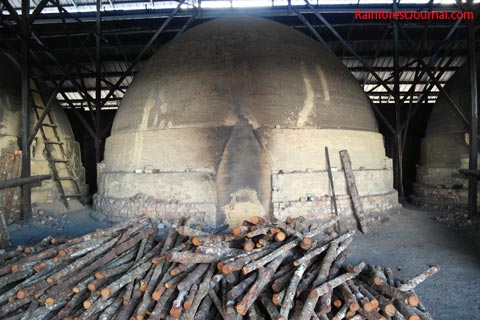
The third stage of charcoal making, involves cutting off the oxygen supply to the fire, and letting it cool slowly.

The charcoal produced at Kuala Sepetang is high grade charcoal.
It is possible to visit the charcoal factory and take an interesting guided tour of the premises. The tours are led by a staff there, Mr Chuah. Basically, the charcoal is produced using a 3-step process. The first step involves smoking the wood using a large flame, for about 10 days, during which time, most of their moisture content is evaporated. The next stage is smoking the wood using low flame for 14 days. Although the flame is small, the second stage is actually hotter due to the buildup of heat inside the kiln. The third stage involves covering up the kiln totally, for about 8 days, so that the fire dies by itself, and the wood is left to cool. The resultant charcoal has a shiny veneer, and produces very little soot.
Flora and fauna of the Matang mangroves
A little further along the road from the charcoal factory (about 100m ahead), and you will arrive at the Kuala Sepetang Eco-Educational Centre. The mangrove forest reserve here is the largest remaining block of mangrove forest left in the Peninsular. It actually stretches all along the coastline from Kuala Gula in the north (there is a bird sanctuary here, the Kuala Gula Bird Sanctuary), to Pantai Remis in the south.

The village of Kuala Sepetang is predominantly Chinese of Hokkien descent. It reminds me of Pulau Ketam, an island off the Selangor coast, albeit very much cleaner. Probably the difference between having a proper garbage disposal service vs none….
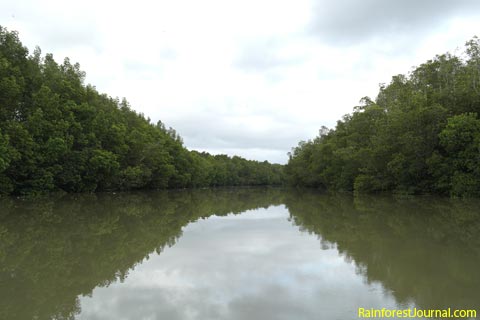
Looking upstream of the Sungai (River) Reba, from the Matang mangrove park jetty during high tide. High tide is when the boats return from their activities (and some rubbish starts floating in).
The topography here is that of a broad river delta, several kilometers deep from the seaward edge. Thus, the mangrove type here is mostly of the intermediate Rhizophora belt, comprising Rhizophora mucronata, and Rhizophora apiculata. The frontal seaward facing belt would comprise mostly Avicennia and Bruguiera species, which are not as common here as compared to say, Kuala Selangor Nature Park.

The different mangrove zones at Matang, based on the dominant species, as shown by an information board at the park. These “zones” denote the succession level of the dominant species, from the seafront, all the way to dry land.

In many spots, young mangrove saplings form a dense understory. Mangrove trees flower and fruit often, and the Forestry Department often carries out the planting of seedlings. Hence, there is never any shortage of seedlings.

The roots of Rhizophora apiculata. R. apiculata and R. mucronata are the only two Rhizophora species found here. They are the “classic” mangrove trees, with their stilt roots. However, they are also very tall here!
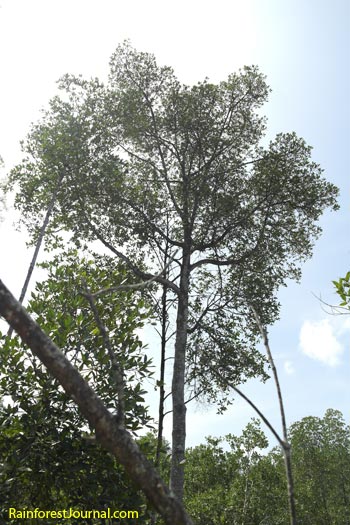
Rhizophora apiculata is by far the commonest species of tree found in the mangroves of Kuala Sepetang.
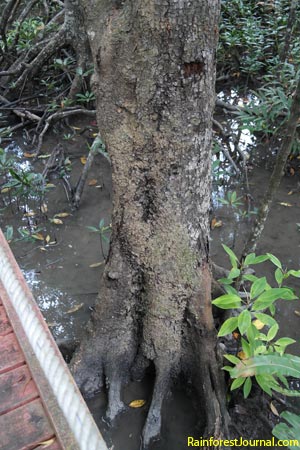
Bruguiera gymnorhiza, found growing by the boardwalk.

Bruguiera trees are also found here in the Rhizophora dominated forest, albeit not very common. Their knee-like roots are characteristic.

The canopy of the mangrove forest towers about 20-30m in height on average, for mature or old growth stands. This is impressive for any mangrove forest; most are much shorter.
The mangrove forests here seem to be in good condition, and there are plenty of areas inside the vast forest reserve that do not seem to have undergone any past timber harvesting. The canopy of the Rhizophora forest here is generally 20-30 m tall, and many of the mangrove trees are old, possibly 50-100 years old. Lying just off the Kuala Sepetang village is an uninhabited island dominated by old growth (primary) mangrove forest, a good example of the Matang mangrove forest in all its glory.

Primary mangrove forest on an island just opposite of Kuala Sepetang village. This nameless island (it has only numerals for its name) has never been logged before, and it is clear the mangrove trees are very tall; some trees could be close to 35 m (or more) in height.
Higher upstream of the rivers, nipah palms will start to appear, and the Berembang trees (Sonneratia caseolaris) start to become more and more common. At Kampung Dew upstream, there is the nightly spectacle of fireflies amongst the Berembang trees which is a major tourist attraction much like the fireflies of Kuala Selangor.
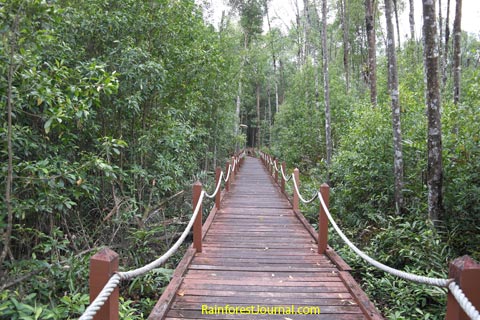
Mangrove wooden boardwalk at the Matang Mangrove Eco-Educational Centre. This boardwalk provides one with the opportunity to “trek” through the mangrove forest in relative comfort.
The long wooden boardwalk here, which spans about a kilometer in total length, provides the perfect opportunity to observe the mangrove forest up close. One sign that the environment here is intact is the (relatively) minimal numbers of mosquitoes, in contrast to other coastal areas that have undergone much disturbance. Although mosquitoes are always present in mangrove swamps, here they are A LOT less abundant here than coastal areas elsewhere! Make sure to bring your insect repellant along, though.
Wildlife is rich, and the good thing about mangrove forests is that their less complex interior allows wildlife to be spotted much easier. You will most certainly encounter the long-tailed macaques (Macaca fasicularis) near the visitor chalets, but the otherwise conspicuous silvered leaf monkey (Trachypithecus cristatus)seems to be absent from the main visitor complex. Leopard cats, smooth otters, pangolins, numerous species of reptiles, and bats are other wildlife species that live here in the mangrove swamps. The boardwalk provides an opportunity to conduct night walks, when many of the mangrove inhabitants are active.

A stump is all that is left of a large Rhizophora apiculata that has died. This is probably one of the notable old trees in the vicinity of the visitor area. The stumps can remain standing for a long time after the tree has died, probably due to relative lack of wood decomposers (although certain termite species are very common here).
Even the birds are easier to spot here, and it’s estimated that there are 155 resident species to be found in and around Kuala Sepetang. In the past, mangroves all along the West coast of Peninsular Malaysia were used by migrating birds to roost and feed. Since most of these habitats have long vanished, the Matang mangroves have become an important stopover instead. Due to its size, it now supports tens of thousands of migrant birds – especially abundant at the Kuala Gula Bird Sanctuary further north.
Note: The Kuala Gula Bird Sanctuary is also part of the Matang mangrove forest, but managed under a different government body, the wildlife department or PERHILITAN.
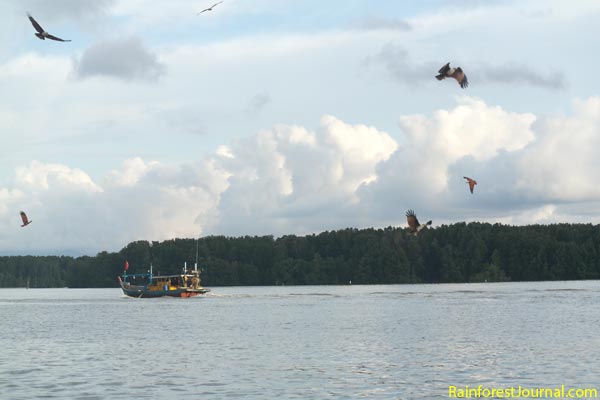
Brahminy kites are common here, and these are already “trained” by the forestry department staff to respond to boat sirens, which to them, means feeding time. Pieces of chicken are thrown into the sea for them to swoop down and snatch with their talons.
Among the commonly seen birds at Kuala Sepetang are Milky storks (Mycteria cinerea), Lesser Adjutant stork (Leptopilos javanicus), Brahminy kites (Haliastur Indus), and White-bellied sea eagles (Haliaeetus leucogaster). The Common Flameback Woodpecker (Dinopium javanense) is one of the striking birds easily spotted near the chalets.
One of the unique highlights about the Kuala Sepetang area is the presence of Chinese White Dolphins (Sousa chinensis) in the river estuaries around here. These dolphins have been spotted by a few (very) lucky people, and to the best of my knowledge, there are no other reports of such dolphins being resident in other parts of Peninsular Malaysia. Dugongs (highly endangered) are also present, as there are beds of seagrass here which they feed on, and it is possible that the Matang mangrove forest may harbor small populations of the estuarine/saltwater crocodile (Crocodylus porosus), in the remote areas of the coastline. All are further indications of the relatively undisturbed nature of the large mangrove habitat here.

Rattans are common in the mangrove forest, whenever there is a clearing, as are the ubiquitous golden leather ferns (Acrostichum aureum), seen at the bottom of the pic. These mangrove ferns grow to huge size in the Matang mangrove forest.
I did notice a key difference between the Matang mangrove forest, and the forest at the Kuala Selangor Nature Park; indeed throughout most of the Selangor coast, the swamp further inland has long been cleared, replaced by dense secondary forest dominated by fig trees/bushes (and home to hordes of mosquitoes!). But here, the original mangroves are still standing, and this is the original forest type that used to cover the lower river deltas throughout the West Coast of Peninsular Malaysia not too long ago. The value of the Matang mangroves simply cannot be overstated.
Other interesting highlights
Worthy of mention is a prehistoric archeological site at Kelumpang Island. It is a 255 ha island nearby, covered in bamboo forest, and has been declared a HVCF (High Value Conservation Forest). Traces of early man have been found here. Another interesting place that I should mention is Pulau Sanggar (Sanggar Island) which hosts a remote Chinese village that is still inhabited by around 200 families who get by without any electricity or piped water!

Visitor chalets at the Matang Eco-Educational Centre are quite adequate. While staying here is the best, there is plenty of accommodation in the form of budget hotels in and around Taiping, as well as floating chalets offshore from Kuala Sepetang, that mostly cater to anglers.

The beautiful Matang mangrove forest, as seen in the evening light. This is without doubt the best area for mangrove conservation in Peninsular Malaysia.
Now that I got back, would I return to Kuala Sepetang? Absolutely. There is still much to explore along this part of the Perak coastline, including visiting the offshore islands by boat. The Matang mangroves is the only place left in Peninsular Malaysia where a vast expanse of the original mangrove ecosystem is conserved, hopefully for many more years to come.

November 21, 2017 at 7:54 am
is there any mangrove plant that can be a cure medicine so far?
November 21, 2017 at 8:16 am
@juleeaj
Yes there are, although knowledge is very limited. https://link.springer.com/article/10.1023/A:1009988607044
March 22, 2018 at 1:26 pm
Is this place wheelchair friendly?
March 22, 2018 at 3:33 pm
@ Joanne
Well, the chalets are all connected by wooden boardwalk and the length is not short at all, so it should be ok for the most part. Some portions of the boardwalk may be dilapidated.
September 12, 2018 at 7:31 am
Are you aware of any fees being imposed upon entering the mangrove area? I went on last monday and there were people there asking for money but they are not in uniform.
September 12, 2018 at 8:31 am
@Gina,
I called the management and was told that since 2015, they started collecting entry fees. RM5 for adults, RM2 for kids, and RM2 for parking.